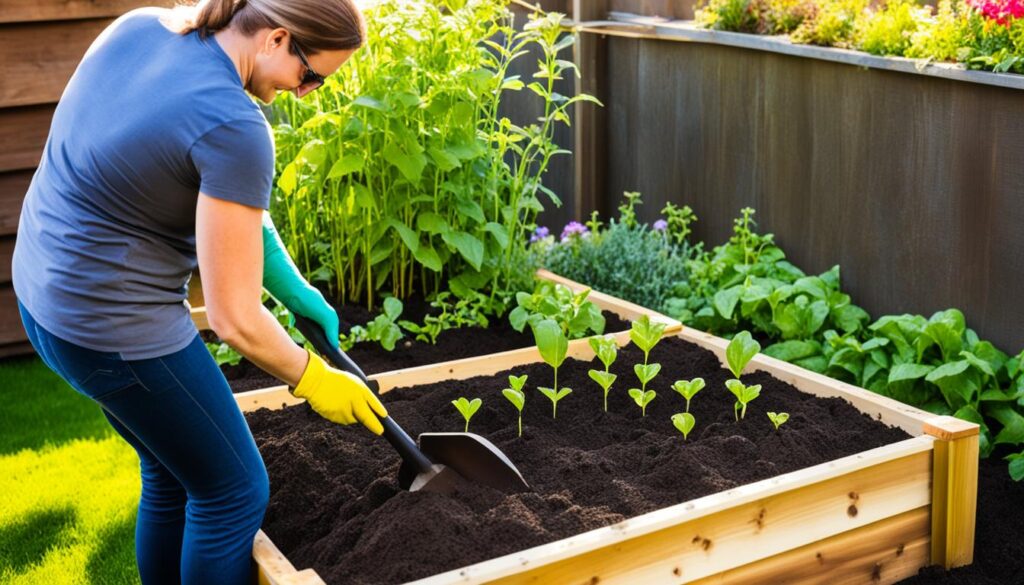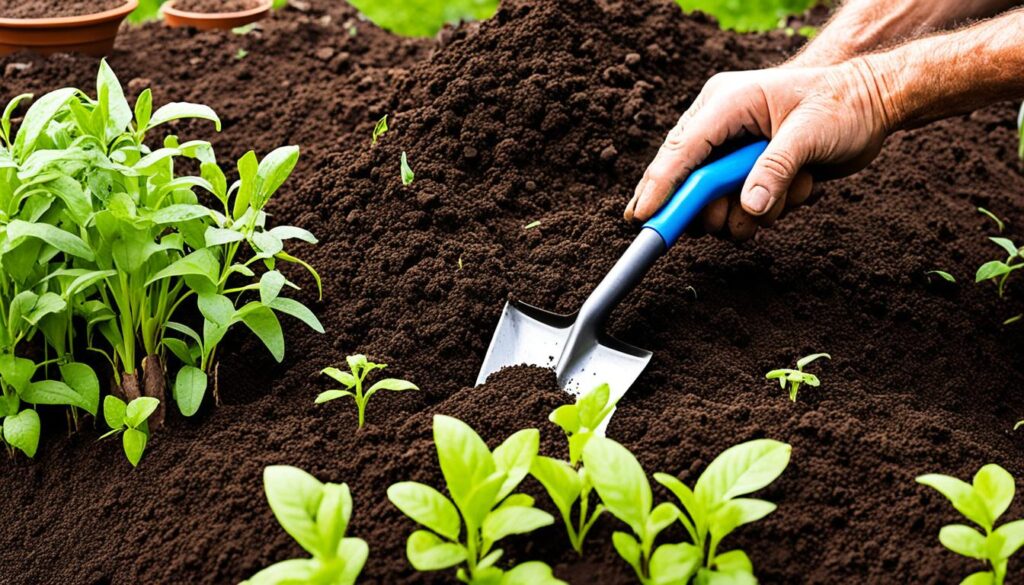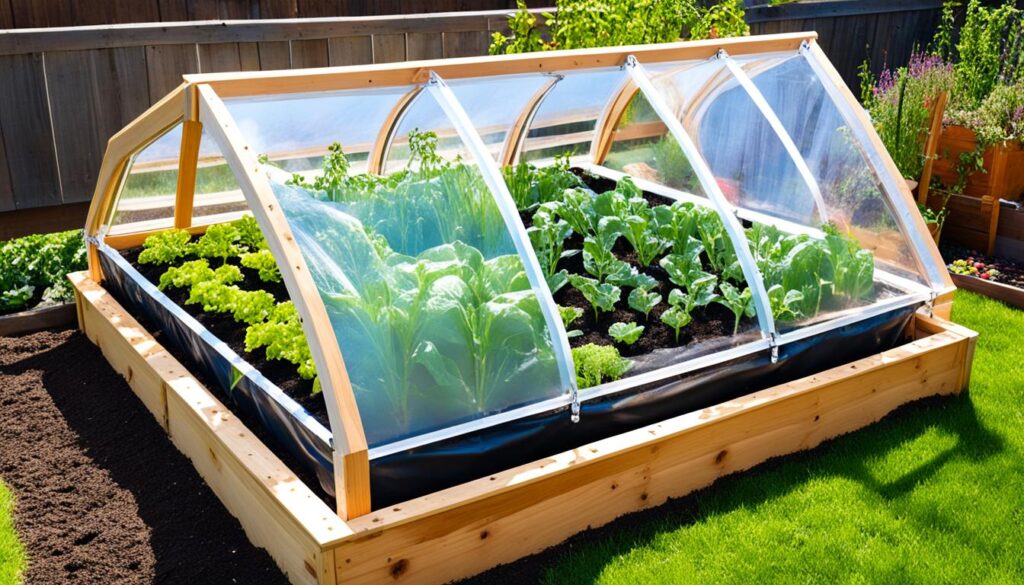Welcome to my gardening guide on improving clay soil for your lawn. Clay soil is a popular choice in the UK, but it comes with its fair share of challenges. Its sticky texture and poor drainage can hinder plant growth and affect the overall health of your lawn. In this article, I will share some valuable tips and best practices for improving clay soil to create a lush and vibrant lawn.
Whether you’re dealing with compaction, acidity, or slow warming in summer, there are effective solutions to enhance your clay soil. By understanding the unique properties of clay soil and implementing the right techniques, you can create a nutrient-rich environment that fosters healthy grass growth.
From balancing soil pH to incorporating organic soil amendments, I will guide you through each step of the process. We’ll also discuss the importance of aeration, choosing the right grass varieties, and proper lawn maintenance to optimize the condition of your clay soil.
So, let’s dive in and discover the secrets to transforming your clay soil into a thriving foundation for a beautiful lawn. Get ready to implement these valuable lawn care soil tips and witness the remarkable improvement in your lawn.
Understanding Clay Soil and its Challenges
Clay soil is composed of fine mineral particles with minimal organic matter. Its sticky texture and high water-holding capacity result in numerous challenges that can hinder plant growth and overall lawn health.
Clay Soil Properties
- Poor Drainage: Due to its composition, clay soil has poor drainage, making it susceptible to water logging and excess moisture.
- Compaction: The small particles in clay soil easily compact, leading to reduced pore space and restricted root growth.
- Acidity: Clay soil tends to be acidic, which can limit nutrient availability to plants.
- Slow Warming in Summer: Clay soil retains heat for longer periods, causing it to warm up slowly during summer.
These challenges can have a significant impact on the health and vitality of lawns grown in clay soil. Therefore, it is crucial to implement appropriate techniques and strategies to overcome these obstacles and create an optimal growing environment.
Overcoming Clay Soil Challenges
To address the challenges posed by clay soil, it is essential to improve its structure and enhance its drainage capabilities. Aeration, soil amendments, and proper maintenance practices can significantly contribute to the health and vitality of lawns grown in clay soil.
| Method | Description |
|---|---|
| Aeration | Aerating the soil helps alleviate compaction and improves overall soil structure by creating channels for air, water, and nutrients to penetrate. |
| Soil Amendments | Adding organic matter, such as compost or well-rotted manure, helps improve the soil’s ability to drain, retain moisture, and provide essential nutrients to plants. |
| Proper Maintenance | Regular mowing, appropriate watering, and a well-planned fertilization schedule can help maintain the health of lawns grown in clay soil. |
By implementing these strategies, lawn owners can create a more favorable environment for the growth of grass and other plants, despite the challenges posed by clay soil.
Improving Clay Soil pH Levels
Clay soil poses a unique challenge in maintaining a healthy lawn due to its natural acidity. The pH level of soil determines how acidic or alkaline it is, and this directly affects the availability of essential nutrients for grass growth. Unfortunately, clay soil tends to be on the acidic side, which can hinder optimal grass growth and health. To ensure lush and robust grass, it is crucial to balance the pH level of clay soil.
Optimal pH for grass growth in clay soil falls within the range of 5.5 to 7. A pH level below 5.5 indicates acidic soil, while a pH level above 7 signifies alkaline soil. Balancing the pH within this range creates the ideal conditions for grass roots to absorb nutrients effectively and thrive. Winter is the best time to check and adjust the pH levels of your clay soil, as it allows for ample time before the growing season begins.
To balance the pH of clay soil, several correction methods can be used. Adding lime, such as dolomitic or calcitic lime, is a common approach to increase alkalinity and raise the pH level. On the other hand, if the soil pH is too high, the addition of sulfur or iron sulfate can help lower acidity and optimize pH levels. Keep in mind that amendment quantities should be based on soil test results and manufacturer recommendations.
Selecting the right fertilizer for clay soil is also crucial in balancing pH levels. There are fertilizers available that specifically address acidic soil conditions, such as those with high calcium content. These fertilizers not only provide essential nutrients for grass growth but also aid in neutralizing soil acidity over time.
It is important to remember that maintaining the optimal pH level for grass growth in clay soil is an ongoing process. Regular soil testing and adjustments as needed will ensure the long-term health and vitality of your lawn. Take the necessary steps to balance the pH level and provide your grass with the best possible environment for growth.
| Soil pH | Acidity/Alkalinity | Effect on Grass |
|---|---|---|
| Below 5.5 | Acidic | Inhibited nutrient absorption, stunted growth |
| 5.5 – 7 | Neutral to slightly acidic | Optimal conditions for grass growth |
| Above 7 | Alkaline | Inefficient nutrient availability, nutrient imbalances |
Aeration for Clay Soil Improvement
Improving the structure of clay soil is crucial for maintaining a healthy lawn. One of the most effective techniques for achieving this is aeration. Aeration helps break down compacted soil and improves its ability to allow air, water, and nutrients to reach the grassroots. By incorporating regular aeration into your lawn care routine, you can address the challenges posed by clay soil and create an environment conducive to optimal plant growth.
There are two primary methods for aerating clay soil: manual aeration using garden tools or using an aerator. Manual aeration tools, such as aerating sandals or a pitchfork, offer a cost-effective solution for small to medium-sized lawns. These tools allow you to create small holes or channels in the soil to alleviate compaction and enhance water infiltration.
If you have a larger lawn or prefer a more efficient and time-saving approach, using an aerator is recommended. Aerators come in various types, such as spike aerators or plug aerators. Spike aerators penetrate the soil surface with spikes, whereas plug aerators remove small plugs of soil. Both methods effectively aerate the soil, but plug aerators provide better results by physically removing soil cores, promoting greater air and water movement.
Spring is the ideal time to aerate clay soil. The weather conditions during spring facilitate the recovery and growth of grass and allow the soil to dry out slightly, making it easier to penetrate. By aerating in spring, you set the stage for a successful growing season by improving the soil structure and enhancing its ability to absorb essential nutrients.
“Aeration is an essential practice for breaking down compacted clay soil and improving its structure.”

Benefits of Aeration for Clay Soil
Aeration offers numerous benefits for clay soil improvement:
- Breaks down compacted soil: Aeration loosens the soil and breaks up compacted layers, allowing grassroots to penetrate deeper.
- Improves soil structure: By creating channels or removing soil cores, aeration helps create a more favorable soil structure, enhancing water infiltration and drainage.
- Enhances nutrient uptake: Improved soil structure allows for better nutrient absorption, leading to healthier grass growth and greener lawns.
- Promotes microbial activity: Aeration increases oxygen levels in the soil, promoting the growth of beneficial microorganisms that contribute to soil health.
- Reduces thatch buildup: Thatch, the accumulation of dead grass and organic matter, hinders water and nutrient movement. Aeration helps reduce thatch buildup, improving overall lawn health.
By incorporating regular aeration as part of your lawn maintenance routine, you can optimize clay soil conditions and facilitate the growth of a lush and healthy lawn.
Soil Amendments for Clay Soil
Improving the health and structure of clay soil is crucial for creating an optimal environment for grass growth. Adding soil amendments can significantly enhance clay soil’s properties and promote better drainage and root establishment. Here are some effective soil amendments to consider:
1. Soil Conditioner
Soil conditioner is a valuable addition to clay soil as it helps break up compacted soil particles and improves aeration. It also enhances water retention and nutrient absorption, creating a more favorable environment for plant growth.
2. Organic Compost
Organic compost is a rich source of organic matter and essential nutrients. Adding compost to clay soil improves its structure, enhances its water-holding capacity, and promotes the growth of beneficial microorganisms that aid in nutrient availability.
3. Calcified Seaweed
Calcified seaweed is a natural soil amendment that adds valuable minerals and trace elements to clay soil. It helps balance the soil’s pH, improves nutrient uptake, and enhances root development and overall plant health.
4. Lime Dressing
Lime dressing is beneficial for clay soil with acidic pH levels. It helps neutralize acidity and raises the pH, creating a more favorable environment for grass growth. Lime also improves the availability of essential nutrients and enhances soil structure.
5. Soil-Sand Mixture
Adding a soil-sand mixture to clay soil can improve its drainage and prevent compaction. Mixing in coarse sand helps loosen the soil, allowing water to drain more effectively and reducing the risk of waterlogging.
6. Compost
In addition to organic compost, incorporating compost made from garden waste can improve the structure and fertility of clay soil. Compost adds organic matter and beneficial microorganisms, enhancing soil structure and promoting nutrient availability to the grass.
By incorporating these soil amendments into your clay soil, you can enhance its health, structure, and fertility, creating an ideal environment for a lush and thriving lawn.
Choosing the Right Grass Varieties for Clay Soil
Selecting the correct grass varieties is crucial for achieving better tolerance and growth in clay soil lawns. Two suitable options for clay soil lawns are Perennial ryegrass and Tall fescues. Both varieties are known for their ability to thrive in clay soil conditions, offering resilience and adaptability.
Perennial ryegrass is a cool-season grass variety that establishes quickly, making it an ideal choice for overseeding in both spring and autumn. It has excellent tolerance to compacted and heavy clay soils, making it an excellent option for lawns that experience foot traffic. Perennial ryegrass forms a lush, dense turf that can withstand wear and tear, ensuring a vibrant lawn all year round.
Tall fescues are another excellent choice for clay soil lawns. They have deep-rooting capabilities that enhance their drought tolerance, enabling them to tolerate the moisture retention properties of clay soil. Tall fescues are known for their ability to maintain their green color even during periods of drought, making them a reliable choice for areas with water scarcity. This grass variety exhibits exceptional tolerance to extreme weather conditions, while also providing good shade tolerance.
Overseeding in both spring and autumn is a beneficial practice for clay soil lawns. It helps to fill in any bare spots, improve coverage, and enhance the overall establishment of the grass. By introducing new grass seed into the existing lawn, you can rejuvenate the soil’s health and density, ensuring a consistently healthy and attractive lawn.
Benefits of Perennial Ryegrass and Tall Fescues for Clay Soil Lawns
Perennial ryegrass and tall fescues are well-suited for clay soil lawns due to their:
- Tolerance to compacted and heavy clay soils
- Ability to establish quickly and fill in bare spots
- Deep-rooting capabilities for improved drought tolerance
- Maintaining green color even during periods of drought
- Resilience to wear and tear
- Good shade tolerance
By choosing the right grass varieties and incorporating overseeding into your lawn care routine, you can ensure better tolerance and growth in clay soil lawns. Perennial ryegrass and tall fescues offer the necessary characteristics to thrive in clay soil conditions, providing you with a lush and resilient lawn that will be the envy of your neighborhood.

Lawn Maintenance for Clay Soil
Proper lawn maintenance is crucial for the health and vitality of clay soil lawns. By following a few key practices, you can ensure your lawn thrives and looks its best throughout the year. Here are some essential tips for maintaining a clay soil lawn:
Fertilization with Organic Fertilizers
Fertilization is an important aspect of maintaining a healthy lawn. For clay soil, it is recommended to use organic fertilizers that promote root growth and improve drainage. Organic fertilizers provide essential nutrients to the soil without the risk of chemical buildup. Apply fertilizers during spring and autumn to give your lawn the nutrients it needs for optimal growth and development.
Regular Mowing
Mowing your lawn at the recommended height and frequency is essential for maintaining its health and preventing disease and pests. When mowing clay soil, it’s important to avoid cutting the grass too short, as this can stress the roots and make the soil more prone to compaction. Keep the mower blade sharp to ensure clean cuts and avoid tearing the grass.
Prevention and Control of Diseases
Clay soil lawns can be susceptible to certain diseases, especially if the soil retains too much moisture. To prevent disease outbreaks, ensure proper drainage by maintaining the lawn’s pH balance and improving soil structure. Regularly monitor your lawn for signs of disease, such as discolored patches or wilting grass. If you notice any issues, consult a lawn care professional for appropriate treatment options.
In clay soil lawns, proper fertilization, regular mowing, and disease prevention are key to maintaining a healthy and vibrant lawn. Remember to use organic fertilizers, mow at the recommended height, and keep an eye out for any signs of disease. By following these best practices, your clay soil lawn will thrive and provide a beautiful outdoor space for you and your family to enjoy.
For a visual representation of these lawn maintenance tips, refer to the table below:
| Lawn Maintenance Tips | Description |
|---|---|
| Fertilize with organic fertilizers | Promotes root growth and drainage |
| Regular mowing | Maintains optimal grass height and prevents disease |
| Prevent and control diseases | Maintain pH balance and improve soil structure |
Implementing these lawn maintenance practices will help your clay soil lawn flourish and create a beautiful outdoor space for you to enjoy.

Autumn Care for Clay Soil
As autumn arrives, it’s time to take special care of your clay soil to ensure its health and vitality during the winter months. By implementing a few essential practices, you can prevent waterlogging, retain vital nutrients, and prepare your lawn for the colder season.
One crucial aspect of autumn lawn care is applying an organic feed that is high in phosphate. This nutrient-rich feed will nourish the soil and provide the necessary elements for strong root development and overall lawn health. Consider using an organic phosphate feed specifically designed for clay soil to maximize the benefits.
Fallen leaves and debris can become a common sight in the autumn months. It’s important to regularly rake these leaves and clear any other debris from your lawn. This not only improves the aesthetics, but it also prevents waterlogging and allows the soil to breathe. By removing the fallen leaves, you ensure that the nutrients can penetrate the soil and benefit the grass roots.
Horticultural grit plays a vital role in autumn lawn care for clay soil. By spreading a thin layer of horticultural grit evenly across the lawn, you can improve drainage and prevent waterlogging. The grit helps create channels for excess water to flow through, reducing the risk of oversaturation. Additionally, the grit provides stability and prevents the soil from becoming compacted.
| Autumn Care for Clay Soil | Benefits |
|---|---|
| Apply organic phosphate feed | Promotes strong root development |
| Rake fallen leaves and debris | Prevents waterlogging and aids nutrient penetration |
| Use horticultural grit | Improves drainage and prevents compaction |
By following these autumn lawn care practices, your clay soil will be better prepared to withstand the challenges of winter. The organic phosphate feed will provide essential nutrients, raking fallen leaves will ensure proper drainage, and horticultural grit will maintain soil structure. Take proactive steps now to enjoy a healthy and vibrant lawn come spring.
Choosing the Right Grass Seed for Clay Soil
Finding the right grass seed mixture designed for clay soil is crucial for better tolerance and growth. When it comes to selecting the perfect grass seed, I highly recommend the IMPRESS: Clay Master grass seed mixture. This specially blended mixture contains tall fescue and perennial ryegrass, offering numerous benefits for your clay soil lawn.
Tall fescue is renowned for its deep rooting system, which allows it to penetrate through the compacted clay soil and access essential nutrients and water. This tolerance to clay soil conditions ensures that your lawn can thrive even in challenging environments.
Perennial ryegrass, on the other hand, provides excellent drought tolerance. It forms a dense, robust turf that can withstand dry spells and retain moisture in the clay soil, reducing the risk of wilting and browning.
Together, these grass varieties in the IMPRESS: Clay Master seed mixture create a resilient and beautiful lawn that can endure the unique challenges posed by clay soil. Whether your lawn is subject to shade or receives full sun, this seed mixture is suitable for various environments.
Benefits of IMPRESS: Clay Master grass seed mixture:
- Deep rooting capability for better nutrient access
- Excellent drought tolerance for optimal moisture retention
- Suitable for both shaded and sunny areas
- Resilient and beautiful lawn
By choosing the IMPRESS: Clay Master grass seed mixture, you can ensure that your lawn has the best start and continues to flourish in clay soil conditions. Prepare to be impressed by the results!
Lawn Fertilization for Clay Soil
Proper fertilization is essential for promoting growth and improving drainage in clay soil throughout the year. By following a fertilizing schedule that includes spring and autumn applications, you can provide your lawn with the necessary nutrients for better root establishment and soil structure.
For spring fertilization, consider using pre-seed fertilizers that are specifically formulated for clay soil. These fertilizers contain a balanced blend of nutrients that support healthy grass growth. Additionally, high nitrogen organic fertilizers can help stimulate growth and improve the overall health of your lawn.
In autumn, fertilizing your clay soil lawn is equally important. This application helps replenish nutrients that may have been depleted during the summer months and prepares the lawn for the coming winter. Look for fertilizers that are designed for clay soil and have a higher phosphate content to support strong root development.
I recommend using liquid seaweed feed as a supplement during the summer months. Liquid seaweed is rich in essential nutrients and trace minerals that can enhance the health and vitality of your lawn, particularly during hotter weather conditions.
“Proper fertilization is the key to maintaining a lush and healthy lawn, especially in clay soil.” – Expert Gardener
Conclusion
Improving clay soil for lawns is a year-round endeavor that requires careful attention and strategic approaches. By implementing the following key strategies, you can transform your clay soil into a healthy and vibrant lawn:
First, balancing the pH levels of the soil is crucial for optimal grass growth. By maintaining a pH between 5.5 and 7, you can create an environment that supports healthy root development and nutrient absorption.
Second, improving soil structure through aeration and amendments helps alleviate compaction and promote better drainage. Regularly aerating your lawn and adding organic compost or soil conditioner can significantly enhance the overall health of your clay soil.
Third, selecting suitable grass varieties is essential for successful lawn establishment. Varieties like perennial ryegrass and tall fescues are particularly well-suited for clay soil and can withstand its challenges.
Lastly, regular lawn maintenance, including proper fertilization and overseeding in the spring and autumn, is crucial. This ensures that your lawn receives the necessary nutrients and promotes strong root growth.
By following these steps, you can overcome the challenges of clay soil and create a lush, healthy lawn that you can enjoy throughout the year.
Key Takeaways:
- Balance the pH levels of your clay soil for optimal grass growth.
- Improve soil structure through aeration and amendments.
- Select grass varieties that are well-suited for clay soil.
- Maintain your lawn through regular fertilization and overseeding.
Remember, managing clay soil requires persistence and dedication, but the end result is a beautiful, thriving lawn that you can be proud of.








